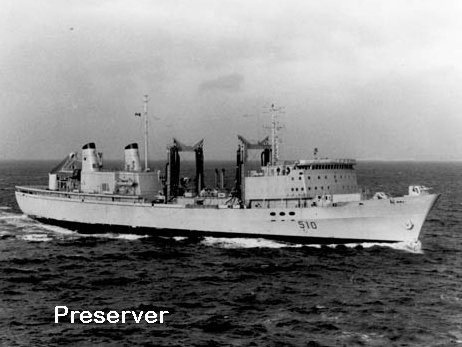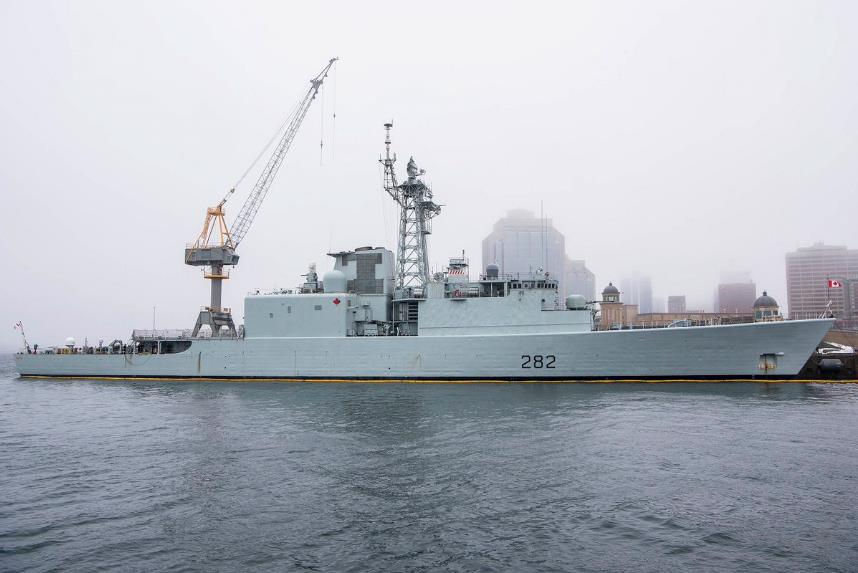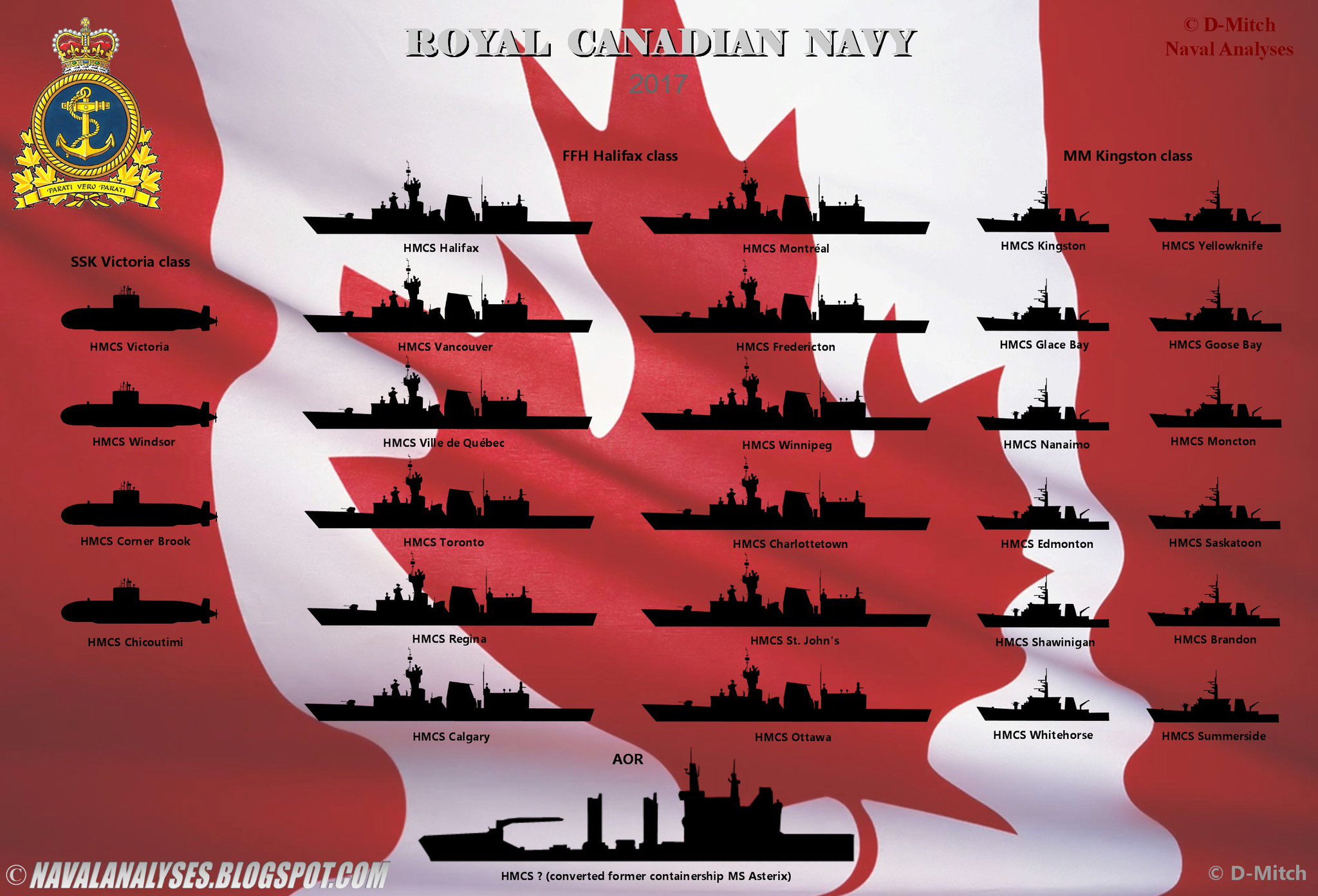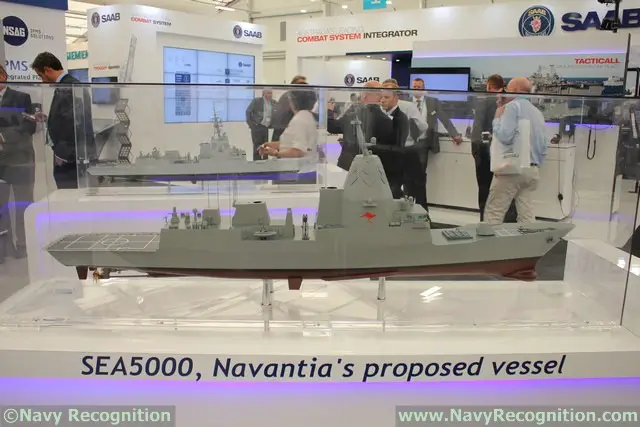 Note the 32 MK41 VLS cells fitted forward. Some (if not all) of them are in their "strike length" version in order to accommodate the Tomahawk LACM.
Royal Canadian Navy Unveils New Details On CSC Frigates
The Royal Canadian Navy (RCN) released the latest details on the configuration of its next generation frigates: the Canadian Surface Combatant (CSC). They will be heavily armed, featuring Naval Strike Missiles, Tomahawk and both ESSM and Sea Ceptor!
Note the 32 MK41 VLS cells fitted forward. Some (if not all) of them are in their "strike length" version in order to accommodate the Tomahawk LACM.
Royal Canadian Navy Unveils New Details On CSC Frigates
The Royal Canadian Navy (RCN) released the latest details on the configuration of its next generation frigates: the Canadian Surface Combatant (CSC). They will be heavily armed, featuring Naval Strike Missiles, Tomahawk and both ESSM and Sea Ceptor!
Xavier Vavasseur 09 Nov 2020
The RCN last week unveiled a PDF document shedding light on the latest configuration retained for its next gen class of frigate: the CSC. Naval News contacted various sources familiar with the program to confirm the selection of a number of systems listed in the document.
What stands out in this new document is fact that the CSC will be fitted with a wide range of weapons, both offensive and defense, in a mix never seen before in any surface combatant.
Naval Strike Missile (NSM)
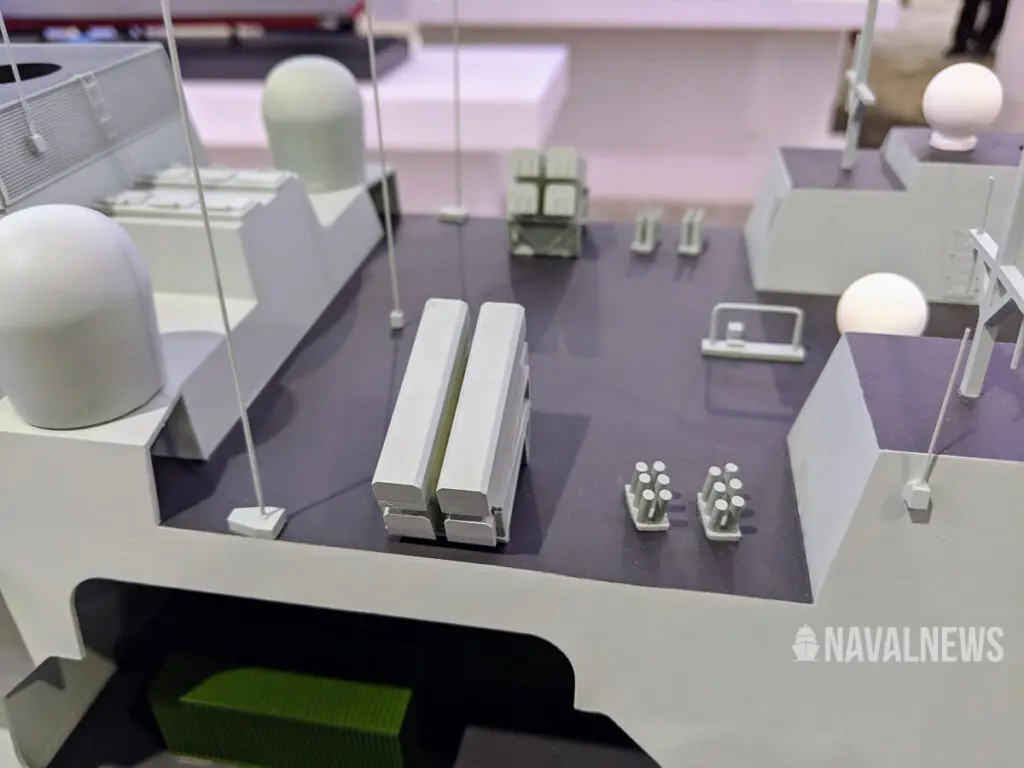 Close up view of the 8 NSM launchers on the CSC scale model on display on the Lockheed Martin booth at Sea Air Space 2019.
Close up view of the 8 NSM launchers on the CSC scale model on display on the Lockheed Martin booth at Sea Air Space 2019.
While NSM launchers were shown in the past on CSC scale models at various tradeshows (Surface Navy and Sea Air Space), the CSC model on display at DSEI 2019 was showing Harpoon launchers aboard the frigate.
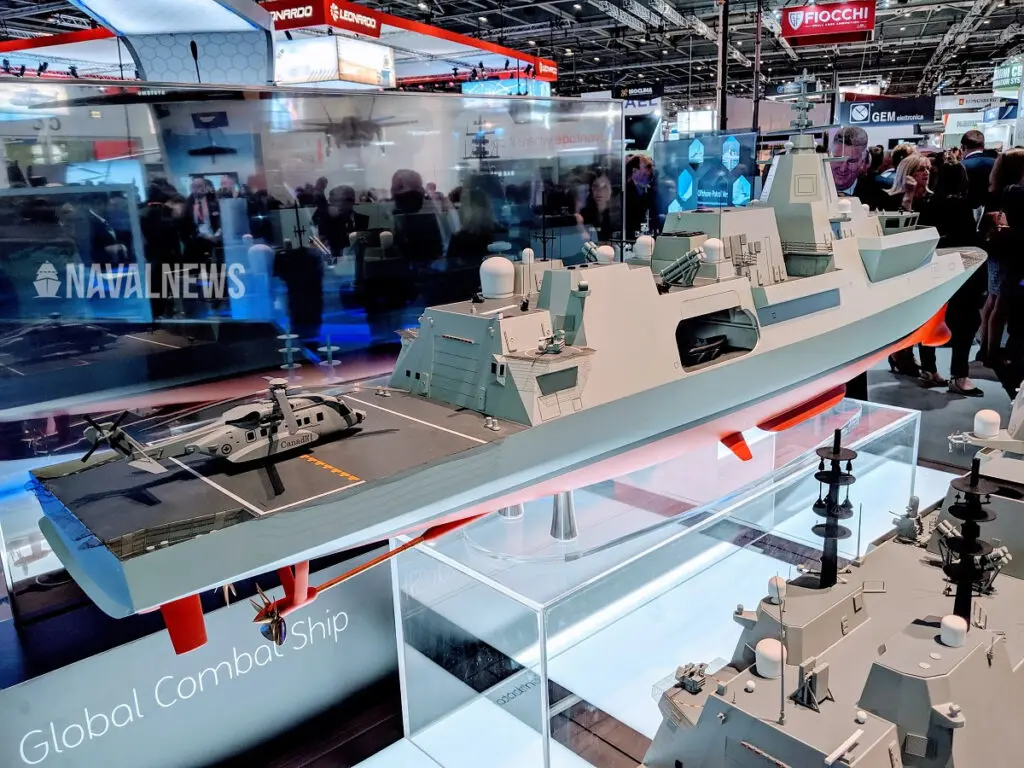 The CSC scale model at DSEI 2019 featured Harpoon launchers.
The CSC scale model at DSEI 2019 featured Harpoon launchers.
To our knowledge, it is the first time that an official Royal Canadian Navy lists the NSM as the main anti-surface warfare (ASuW) weapon for the CSC. Contacted by Naval News, an industry source said Kongsberg was close to finalizing the deal.
NSM has an operational range of 100 nautical miles (185 Km) and a high subsonic speed. It uses Inertial, GPS and terrain-reference navigation and imaging infrared homing (with a target database aboard the missile). The NSM is a fifth generation anti-sip missile, produced by Kongsberg and managed in the U.S. by Raytheon. NSM reached Initial Operational Capability on the Norwegian Fridtjof Nansen-class frigates and Skjold-class corvettes in 2012. It is also fielded by the Polish Navy (coastal defense batteries) and has been selected by the navies of Malaysia and Germany. NSM was also selected in 2018 as the winner of the U.S. Navy Over-The-Horizon Weapon System (OTH WS) competition and by the USMC last year. It will be fitted aboard the Littoral Combat Ship and the Constellation-class frigates. In the case of Canada, is selected, the NSM will likely be sourced from Raytheon via an FMS deal, rather than procured directly from Norway.
Tomahawk land attack cruise missile
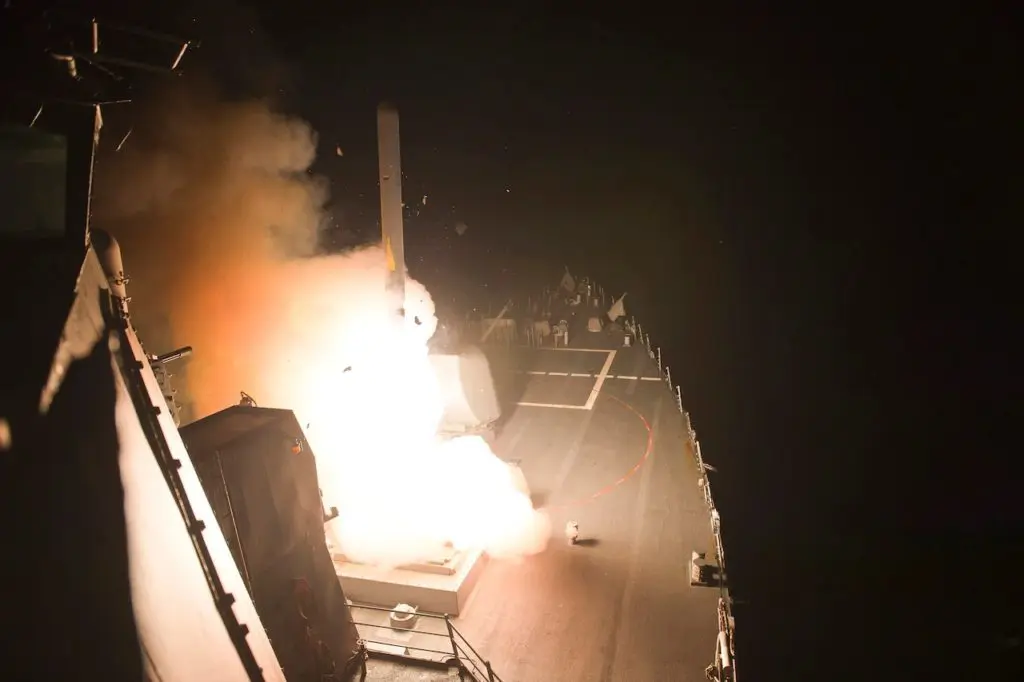 The guided-missile destroyer USS Arleigh Burke launches Tomahawk cruise missiles to conduct strikes against ISIS targets, Sept. 23, 2014. Photo By: Navy Petty Officer 2nd Class Carlos M. Vazquez II.
The guided-missile destroyer USS Arleigh Burke launches Tomahawk cruise missiles to conduct strikes against ISIS targets, Sept. 23, 2014. Photo By: Navy Petty Officer 2nd Class Carlos M. Vazquez II.
If Tomahawk missiles end up in the CSC weapons package, this would be quite significant. So far, Raytheon’s land attack cruise missile has only been exported to the United Kingdom in its submarine launched variant. Canada would become the second export customer for the missile and the only navy, with the US Navy to deploy it from surface vessels.
Naval News contacted Raytheon for comment but we have not heard back yet. During the Sea Air Space 2019 tradeshow, representatives from Lockheed Martin Canada confirmed to Naval News the MK41 VLS aboard the frigate were “strike length”.
The Tomahawk Land Attack Missile (TLAM) is a long-range, all-weather, jet-powered, subsonic cruise missile that is primarily used by the United States Navy and Royal Navy in ship- and submarine-based land-attack operations. Its latest variant, the RGM/UGM-109E Tomahawk Land Attack Missile (TLAM Block IV) has a range of 900 nautical miles (or 1,000 mi / 1,700 km).
ESSM and Sea Ceptor
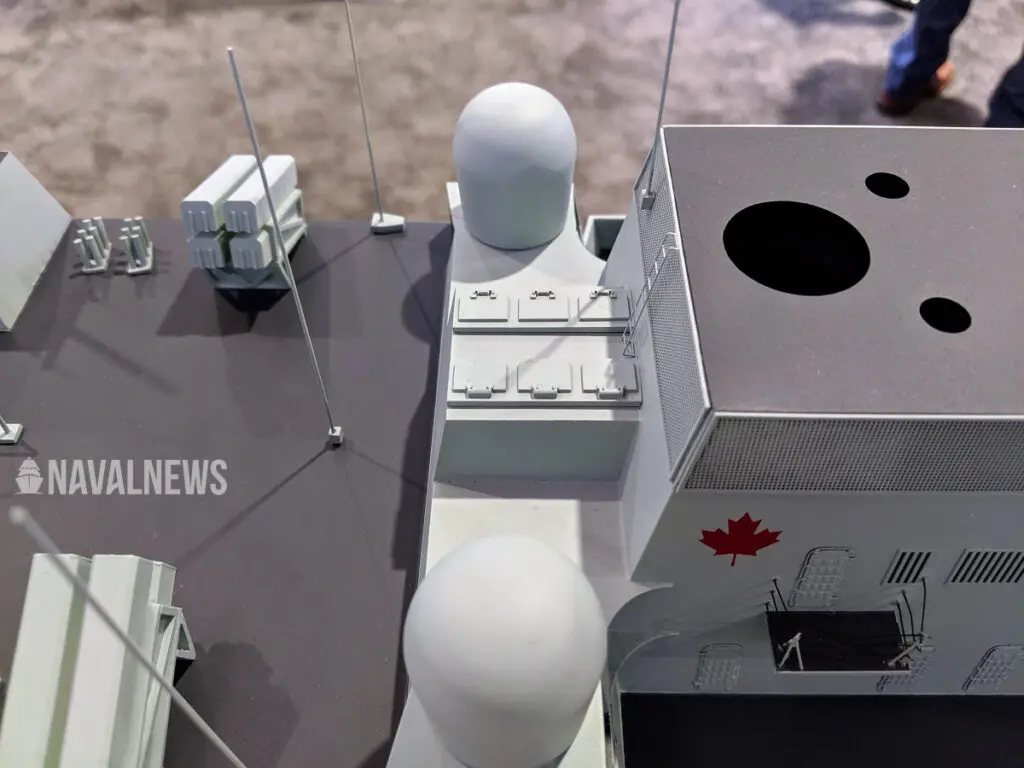 These are likely the ExlS cells for MBDA’s Sea Ceptor. The configuration would be 6 cells each carrying four missiles.
These are likely the ExlS cells for MBDA’s Sea Ceptor. The configuration would be 6 cells each carrying four missiles.
The last thing that really caught our attention in the RCN document is the fact that both the ESSM and Sea Ceptor are listed. On paper, the two missiles are direct competitors and redundant:
ESSM is a medium-range, all-weather, semi-active radar-guided missile used in surface-to-air and surface-to-surface roles. According to open sources, the RIM-162 Evolved SeaSparrow Missile (ESSM) has a range of about 27 nautical miles (50 Km) and a top speed of Mach 4+. Unlike ESSM Block 1, the Block 2’s active radar homing seeker will support terminal engagement without the launch ship’s target illumination radars. The improved ESSM Block 2 will be fielded by the US Navy from 2020. Canada is one of the 12 nations taking part in the NATO-led ESSM consortium and will be deploying the Block 2 variant aboard the future CSC. The will be launched from the Mk41 VLS. The missiles can be “quad packed” in a single cell.
According to MBDA, Sea Ceptor is the next-generation, ship-based, all-weather, air defence weapon system. The Weapon System has the capability to intercept and thereby neutralise the full range of current and future threats including combat aircraft and the new generation of supersonic anti-ship missiles. Capable of multiple channels of fire, the system will also counter saturation attacks. It has a range of 25 Km, a speed of Mach 3 and features an active RF seeker. Also known as Common Anti-Air Modular Missile (Maritime) – CAMM(M), this new missiles has already been fielded aboard the Royal Navy’s Type 23 frigates and the Royal New Zealand Navy ANZAC-class frigates. Sea Ceptor will also be fitted aboard the future Type 26 frigates.
Contacted by Naval News, an MBDA source shed some light on how the Sea Ceptor was selected in addition to the ESSM. The two missiles were not competing against each other. Raytheon’s ESSM was selected to provide “point defense”. Instead, MBDA pitched its missile for the RCN’s close in weapons system (CIWS) requirement. The Sea Ceptor beat out systems usually used in that role such as the RAM, SeaRam or Phalanx. The final Sea Ceptor configuration aboard the CSC still needs finalized and confirmed but it will likely be 24x missiles launched from Lockheed Martin’s Extensible Launching System (ExLS) located amidship. The RCN would become the launch customer for that new launcher alongside the Brazilian Navy (for its new corvette design based on the TKMS MEKO A-100) depending on who signs the contract first.
CSC latest configuration
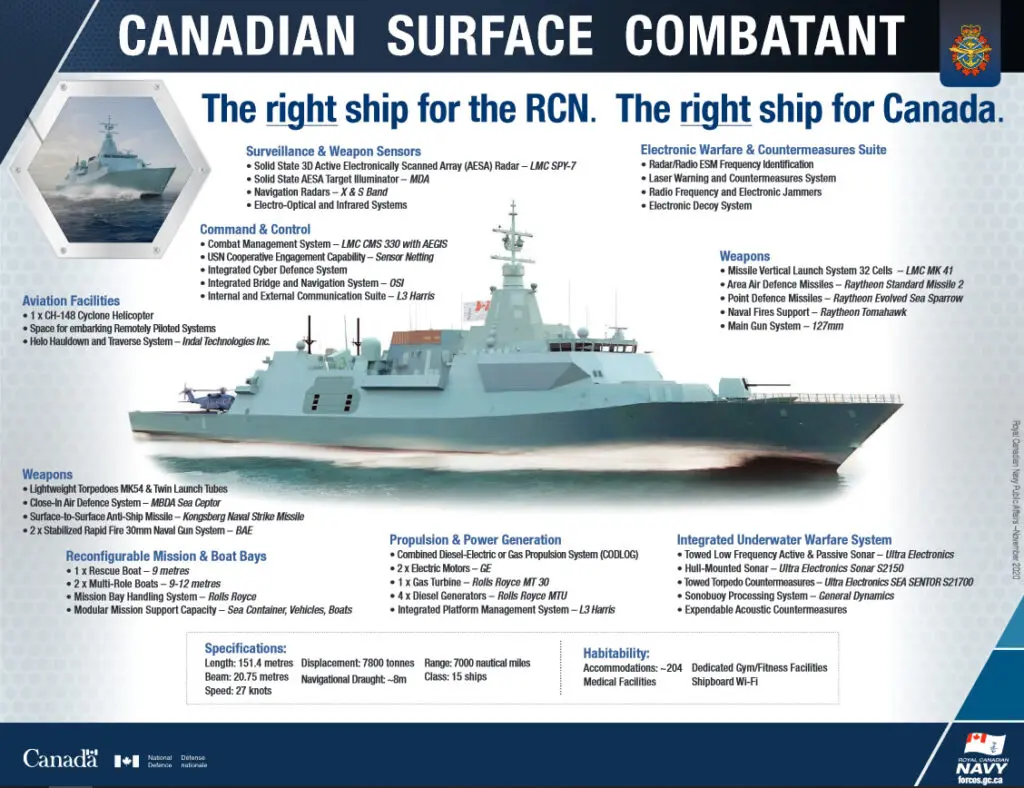 Surveillance & Weapon Sensors
Surveillance & Weapon Sensors
Solid State 3D Active Electronically Scanned Array (AESA) Radar – LMC SPY-7
Solid State AESA Target Illuminator – MDA
Navigation Radars – X & S Band
Electro-Optical and Infrared Systems
Electronic Warfare & Countermeasures Suite
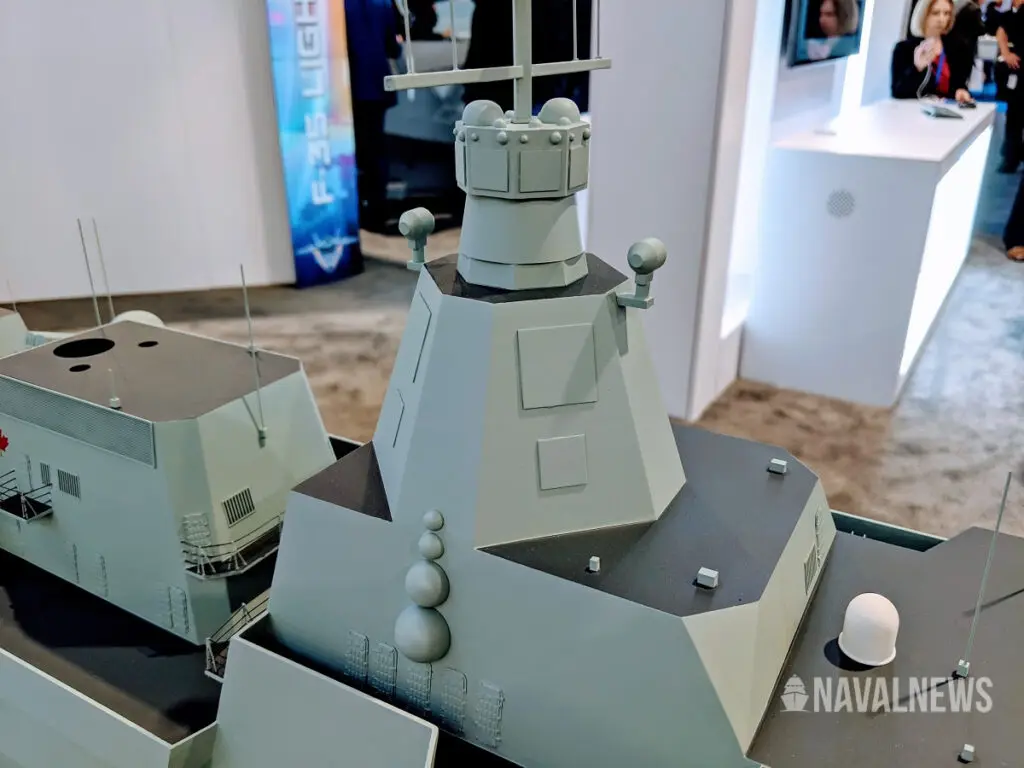 The semi-spherical arrays is part of the RAVEN electronic warfare system comprising communications electronic support measures (C-ESM), radar electronic support measures (C-ESM), and electronic attack (EA). Above them are the SPY-7 radar arrays and two EO/IR systems.
The semi-spherical arrays is part of the RAVEN electronic warfare system comprising communications electronic support measures (C-ESM), radar electronic support measures (C-ESM), and electronic attack (EA). Above them are the SPY-7 radar arrays and two EO/IR systems.
Radar/Radio ESM Frequency Identification
Laser Warning and Countermeasures System
Radio Frequency and Electronic Jammers
Electronic Decoy System
Naval News comments: An industry source informed us that except for the Torpedo decoy systems (to be provided by Ultra) the decoy launchers for CSC and their ammunition is one of the few systems that are still “up in the air”. We were told however that the RCN wants the full range of decoy types available on the market today: Infra red, chaff, corner reflectors, smoke for masking / screening and even offboard active decoys (such as Nulka). The EW suite of the CSC will be known as the RAVEN. Designed by Lockheed Martin Canada, it is based on the RAMSES system currently fitted aboard the Halifax-class frigates.
Command & Control
Combat Management System – LMC CMS 330 with AEGIS
USN Cooperative Engagement Capability – Sensor Netting
Integrated Cyber Defence System
Integrated Bridge and Navigation System – OSI
Internal and External Communication Suite – L3 Harris
Aviation Facilities
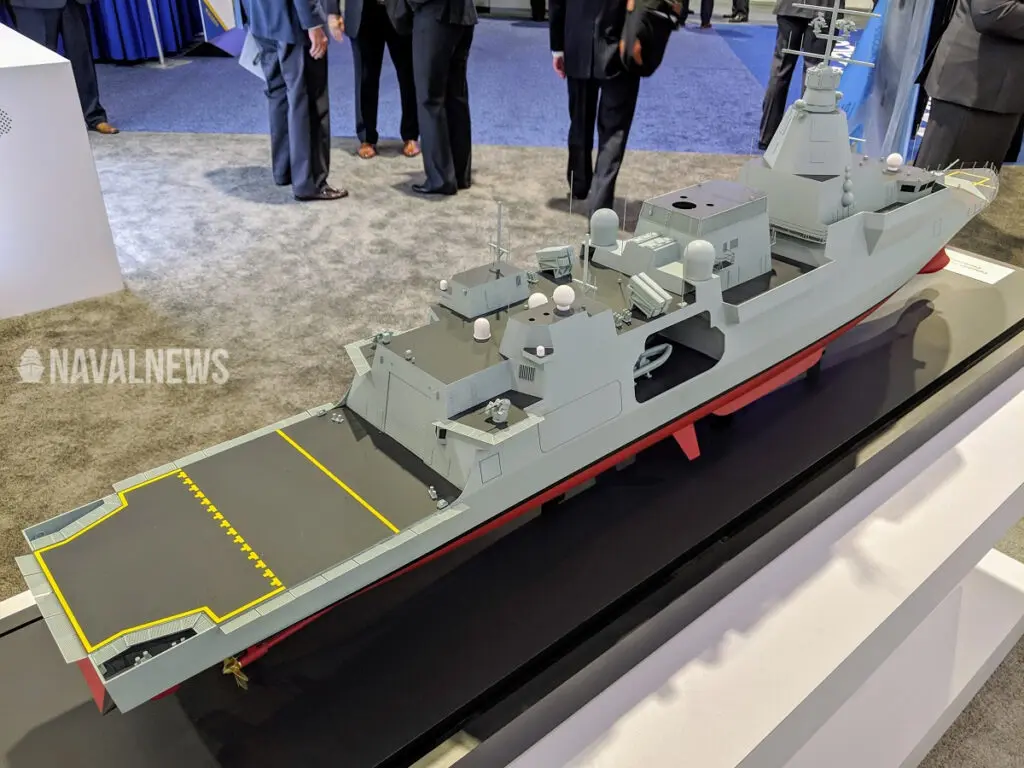
1 x CH-148 Cyclone Helicopter
Space for embarking Remotely Piloted Systems
Helo Hauldown and Traverse System – Indal Technologies Inc
Weapons
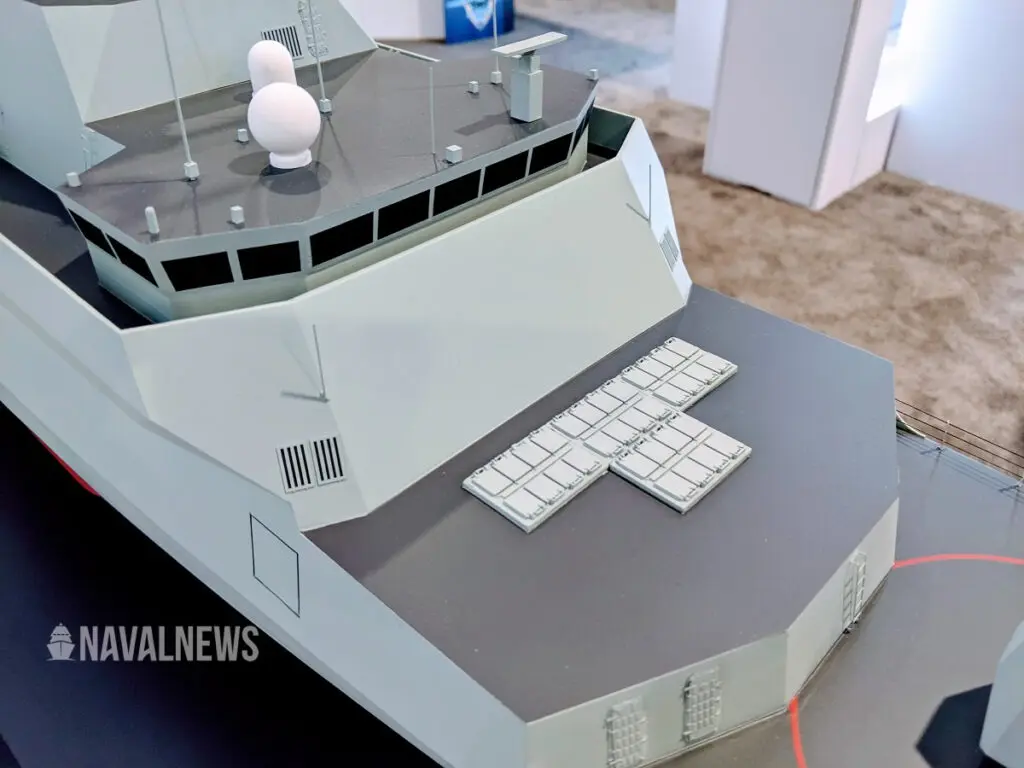
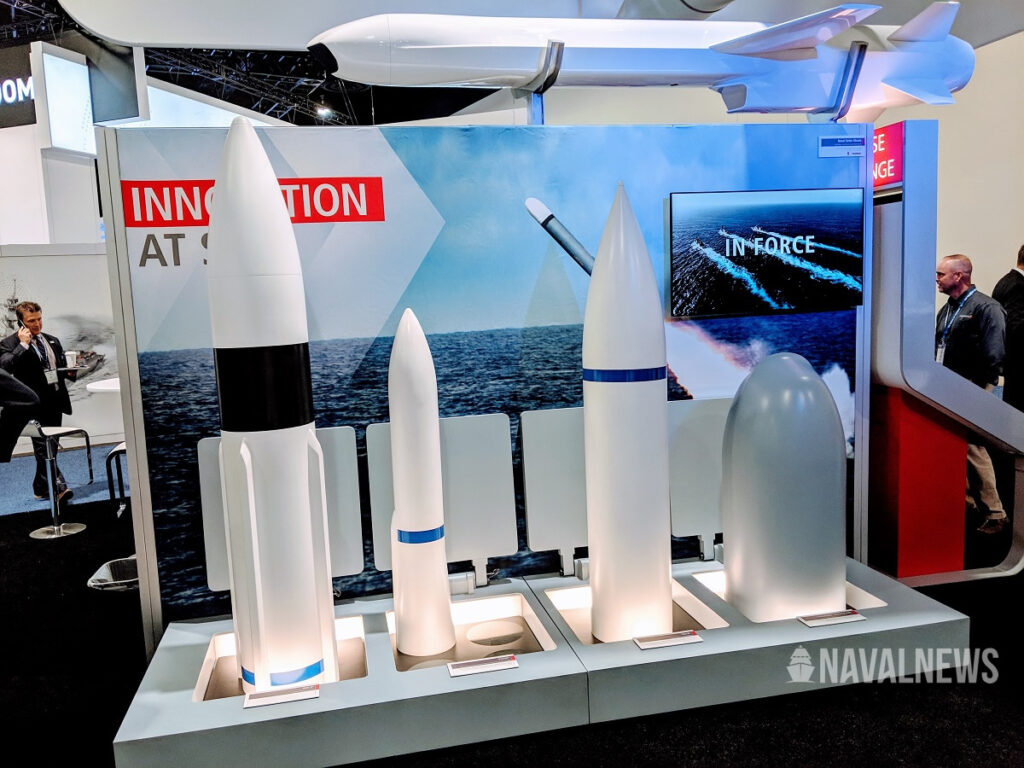
Missile Vertical Launch System 32 Cells – LMC MK 41
Area Air Defence Missiles – Raytheon Standard Missile 2
Point Defence Missiles – Raytheon Evolved Sea Sparrow
Naval Fires Support – Raytheon Tomahawk
Main Gun System – 127mm
Lightweight Torpedoes MK54 & Twin Launch Tubes
Close-In Air Defence System – MBDA Sea Ceptor
Surface-to-Surface Anti-Ship Missile – Kongsberg Naval Strike Missile
2 x Stabilized Rapid Fire 30mm Naval Gun System – BAE
Naval News comments: The main gun is another system on which the RCN has yet to formally make a choice. According to our sources, Italy’s Leonardo 127/64 LW is still in competition against BAE System’s Mk45 Mod 4. Note that the CSC scale models and illustrations (above) have always shown the American gun. In addition, the UK’s Type 26 and Australia’s Hunter-class frigates will both use the later naval gun system. A possible FMS of SM-2 Block IIIC missiles for the CSC was approved last week.
Reconfigurable Mission & Boat Bays
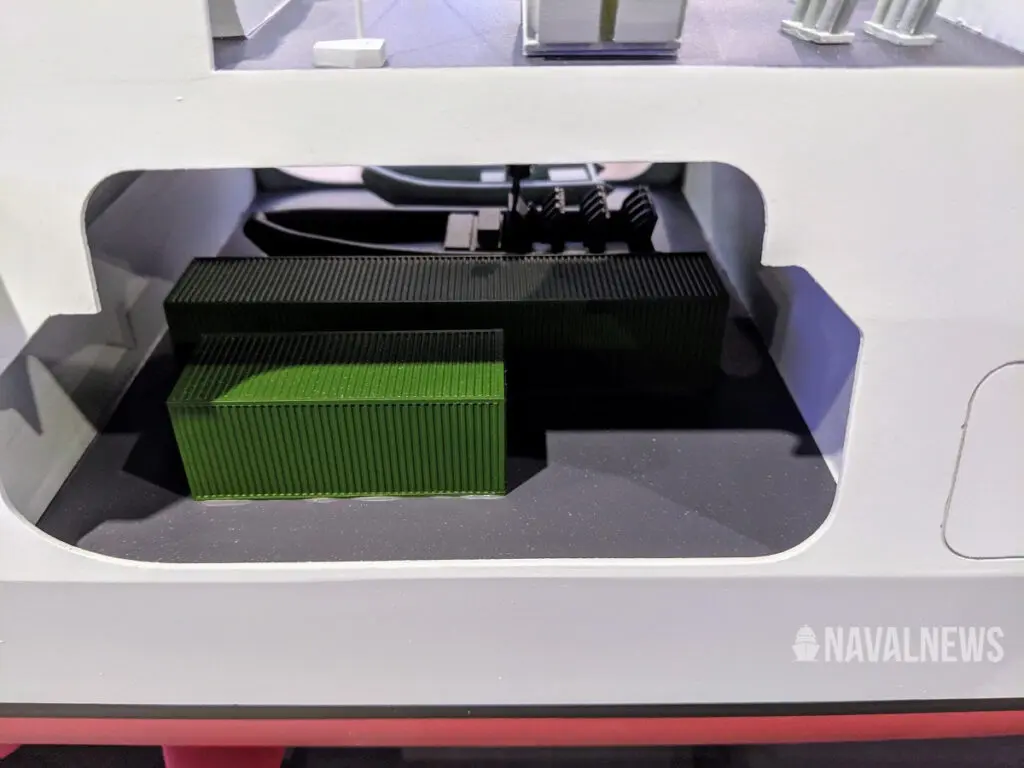
1 x Rescue Boat – 9 metres
2 x Multi-Role Boats – 9-12 metres
Mission Bay Handling System – Rolls Royce
Modular Mission Support Capacity – Sea Container, Vehicles, Boats
Propulsion & Power Generation
Combined Diesel-Electric or Gas Propulsion System (CODLOG)
2 x Electric Motors – GE
1 x Gas Turbine – Rolls Royce MT 30
4 x Diesel Generators – Rolls Royce MTU
Integrated Platform Management System – L3 Harris
Integrated Underwater Warfare System
Towed Low Frequency Active & Passive Sonar – Ultra Electronics
Hull-Mounted Sonar – Ultra Electronics Sonar S2150
Towed Torpedo Countermeasures – Ultra Electronics SEA SENTOR S21700
Sonobuoy Processing System – General Dynamics
Expendable Acoustic Countermeasures
Specifications:
Length: 151.4 metres
Beam: 20.75 metres
Speed: 27 knots
Displacement: 7,800 tonnes
Navigational Draught: ~8m
Range: 7000 nautical miles
Class: 15 ships
Accommodations: ~204
Naval News comments: The displacement figure (7,800 tonnes) shown on the RCN document is probably the “full load” displacement. For comparison, the official figure for the Royal Navy’s Type 26 frigate is 6,900 tons standard displacement while the official figure for the Royal Australian Navy’s Hunter-class frigate is 8,800 tons at full load.
In addition to the PDF unveiled last week, the Royal Canadian Navy Director of Naval Strategy, Captain Nucci, published an article on CSC in USNI’s proceedings:
“Canada is pursuing a single class of 15 surface combatants for the Royal Canadian Navy (RCN), unlike some of its allies who are building multiple classes of more specialized ships. A single variant Canadian Surface Combatant (CSC) is better than the project’s original vision of two variants based on a common hull (the first a task group command/air-defense version, the other a more general-purpose/antisubmarine warfare version). While all naval force structure is essentially driven by national strategic defense and security interests, a single-class solution is based on three principal factors. First, it fits best for Canada’s unique naval requirements shaped by its geography, modest fleet size, and the RCN’s operational needs. Second, it optimizes effectiveness now and into the future, while responsibly seeking maximum cost efficiencies. Finally, it is an innovative approach that has only recently become both practical and advantageous because of recent technological developments, such as convergence and digitization.”
Captain Christopher Nucci, Royal Canadian Navy, Proceedings, USNI, November 2020
https://www.navalnews.com/naval-news/20 ... -frigates/

